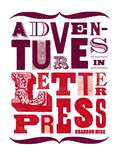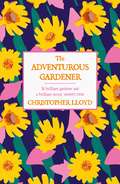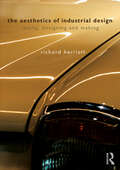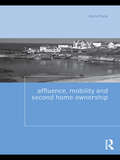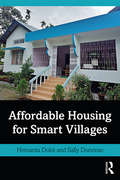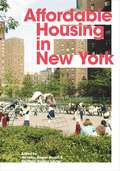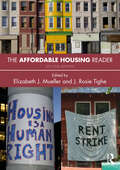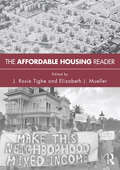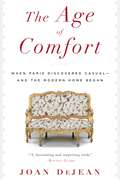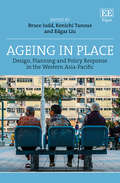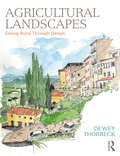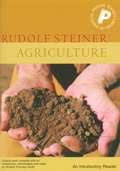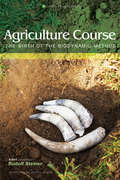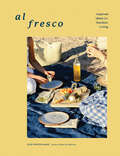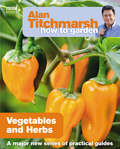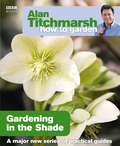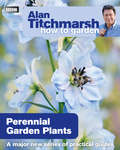- Table View
- List View
Adventures in Letterpress
by Brandon MiseTactile, retro and idiosyncratic, hand-printed objects have an undeniable appeal, especially in a digital age. In recent years, the nearly obsolete craft of letterpress has been resurrected by artists and designers who have rescued cast-iron presses from basements and scrap yards. Adventures in Letterpress features over 200 examples of the resulting work: elegant cards, edgy broadsheets and everything in between. Beautiful, humorous and sometimes just plain weird, the projects featured in the book perfectly illustrate the vibrant future of this once-endangered medium.
The Adventurous Gardener
by Christopher Lloyd'The best informed, liveliest and most innovative gardening writer of our times' GUARDIAN'Christopher Lloyd ranks with Gertrude Jekyll and Vita Sackville-West as one of the major figures in twentieth-century British gardening' THE TIMESIn this gardening classic the forever adventurous Christopher Lloyd takes us on a tour through the garden, to encourage, to reveal and to overturn the old and accepted when experience prompts him. He advises on cuttings, pruning, the art of compromise and takes another look at Miss Jekyll. Gardening was a passion, and throughout his life he developed Great Dixter to be one of Britain's greatest gardens. For Christo gardening is nothing if not fun and - pointing out that 'to be roused into an argumentative frame of mind is in itself no bad thing' - he makes it equally stimulating and enjoyable for his readers.
The Aesthetics of Industrial Design: Seeing, Designing and Making
by Richard HerriottThis textbook introduces design students to key principles of three-dimensional form, bridging aesthetics and practical design objectives. It explores how we see and what it is that characterises visually appealing and satisfactory design. Written by an experienced designer, educator and researcher, The Aesthetics of Industrial Design equips students with the knowledge and understanding of how aesthetically superior design is distinct from lesser work. It explains the key principles and concepts they can incorporate into their own designs, encourages readers to investigate and experiment with real design problems and enables them to verbally communicate their design intentions. The book prompts readers to critically reflect on their work and surroundings. Through numerous clear examples and illustrated case studies, which are guided by cognitive science and the application of aesthetic theory, the book brings together the basic aspects of design as form-giving. It explores the balance of function, material and appearance in detail and explains the reasons for common aesthetic faults and how to avoid them. Aimed at undergraduate- and postgraduate-level students within the design fields, this book reveals the secrets to aesthetically successful products that readers can take from education into future practice.
The Aesthetics of Industrial Design: Seeing, Designing and Making
by Richard HerriottThis textbook introduces design students to key principles of three-dimensional form, bridging aesthetics and practical design objectives. It explores how we see and what it is that characterises visually appealing and satisfactory design. Written by an experienced designer, educator and researcher, The Aesthetics of Industrial Design equips students with the knowledge and understanding of how aesthetically superior design is distinct from lesser work. It explains the key principles and concepts they can incorporate into their own designs, encourages readers to investigate and experiment with real design problems and enables them to verbally communicate their design intentions. The book prompts readers to critically reflect on their work and surroundings. Through numerous clear examples and illustrated case studies, which are guided by cognitive science and the application of aesthetic theory, the book brings together the basic aspects of design as form-giving. It explores the balance of function, material and appearance in detail and explains the reasons for common aesthetic faults and how to avoid them. Aimed at undergraduate- and postgraduate-level students within the design fields, this book reveals the secrets to aesthetically successful products that readers can take from education into future practice.
Affluence, Mobility and Second Home Ownership (Housing and Society Series)
by Chris ParisDespite the current recession, the frequency of second home ownership is still surprisingly high throughout the western world. While the UK and Ireland previously had lower occurrences of multiple dwellings compared to the rest of Europe, they are quickly catching up with a current surge in the ownership of second homes. The recent MP expenses scandal in the UK has also drawn attention to the prevalence of second homes (or more) within the middle classes, and the fact that the concept is becoming increasingly popular. Chris Paris uses this text to address the reasons behind why second homes are becoming more popular, both within the usual domicile of the individuals, and in international locations. The socioeconomic factors and historical contexts of homes in cultures across the world are fundamental to explaining the choices in transnational home ownership, and Paris’ case studies and comparisons between additional homes in Europe, Australia, America and Asia expand upon the motivation for people to own a second home. Affluence, Mobility and Second Home Ownership draws together debates on gentrification, globalisation, consumerism, environmental factors and investment to provide a balanced look at the pros, and cons, of second home ownership, and what implications it has for the future. An ideal text for students studying geography, urbanism and planning, this book is also of interest to individuals interested in the changing ways in which we make choices on our places of residence.
Affluence, Mobility and Second Home Ownership (Housing and Society Series)
by Chris ParisDespite the current recession, the frequency of second home ownership is still surprisingly high throughout the western world. While the UK and Ireland previously had lower occurrences of multiple dwellings compared to the rest of Europe, they are quickly catching up with a current surge in the ownership of second homes. The recent MP expenses scandal in the UK has also drawn attention to the prevalence of second homes (or more) within the middle classes, and the fact that the concept is becoming increasingly popular. Chris Paris uses this text to address the reasons behind why second homes are becoming more popular, both within the usual domicile of the individuals, and in international locations. The socioeconomic factors and historical contexts of homes in cultures across the world are fundamental to explaining the choices in transnational home ownership, and Paris’ case studies and comparisons between additional homes in Europe, Australia, America and Asia expand upon the motivation for people to own a second home. Affluence, Mobility and Second Home Ownership draws together debates on gentrification, globalisation, consumerism, environmental factors and investment to provide a balanced look at the pros, and cons, of second home ownership, and what implications it has for the future. An ideal text for students studying geography, urbanism and planning, this book is also of interest to individuals interested in the changing ways in which we make choices on our places of residence.
Affordable Housing for Smart Villages
by Hemanta Doloi Sally DonovanThis book initiates a fresh discussion of affordability in rural housing set in the context of the rapidly shifting balance between rural and urban populations. It conceptualises affordability in rural housing along a spectrum that is interlaced with cultural and social values integral to rural livelihoods at both personal and community level. Developed around four intersecting themes: explaining houses and housing in rural settings; exploring affordability in the context of aspirations and vulnerability; rural development agendas involving housing and communities; and construction for resilience in rural communities, the book provides an overview of some of the little understood and sometimes counter-intuitive best practices on rural affordability and affordable housing that have emerged in developing economies over the last thirty years. Drawing on practice-based evidence this book presents innovative ideas for harnessing rural potential, and empowering rural communities with added affordability and progressive development in the context of housing and improved living standards. For a student aspiring to work in rural areas in developing countries it is an introduction to and map of some key solutions around the critical area of affordable housing For the rural development professional, it provides a map of a territory they rarely see because they are absorbed in a particular rural area or project For the academic looking to expand their activities into rural areas, especially in rural housing, it provides a handy introduction to a body of knowledge serving 47% of the world's population, and how this differs from urban practice For the policy makers, it provides a map for understanding the dynamics around rural affordability, growth potential and community aspirations helping them to devise appropriate intervention programs on rural housing and development
Affordable Housing for Smart Villages
by Hemanta Doloi Sally DonovanThis book initiates a fresh discussion of affordability in rural housing set in the context of the rapidly shifting balance between rural and urban populations. It conceptualises affordability in rural housing along a spectrum that is interlaced with cultural and social values integral to rural livelihoods at both personal and community level. Developed around four intersecting themes: explaining houses and housing in rural settings; exploring affordability in the context of aspirations and vulnerability; rural development agendas involving housing and communities; and construction for resilience in rural communities, the book provides an overview of some of the little understood and sometimes counter-intuitive best practices on rural affordability and affordable housing that have emerged in developing economies over the last thirty years. Drawing on practice-based evidence this book presents innovative ideas for harnessing rural potential, and empowering rural communities with added affordability and progressive development in the context of housing and improved living standards. For a student aspiring to work in rural areas in developing countries it is an introduction to and map of some key solutions around the critical area of affordable housing For the rural development professional, it provides a map of a territory they rarely see because they are absorbed in a particular rural area or project For the academic looking to expand their activities into rural areas, especially in rural housing, it provides a handy introduction to a body of knowledge serving 47% of the world's population, and how this differs from urban practice For the policy makers, it provides a map for understanding the dynamics around rural affordability, growth potential and community aspirations helping them to devise appropriate intervention programs on rural housing and development
Affordable Housing in New York: The People, Places, and Policies That Transformed a City
by Nicholas Dagen Bloom Matthew Gordon LasnerA richly illustrated history of below-market housing in New York, from the 1920s to todayA colorful portrait of the people, places, and policies that have helped make New York City livable, Affordable Housing in New York is a comprehensive, authoritative, and richly illustrated history of the city's public and middle-income housing from the 1920s to today. Plans, models, archival photos, and newly commissioned portraits of buildings and tenants by sociologist and photographer David Schalliol put the efforts of the past century into context, and the book also looks ahead to future prospects for below-market subsidized housing. A dynamic account of an evolving city, Affordable Housing in New York is essential reading for understanding and advancing debates about how to enable future generations to call New York home.
Affordable Housing in New York: The People, Places, and Policies That Transformed a City
by Nicholas Dagen Bloom Matthew Gordon LasnerA richly illustrated history of below-market housing in New York, from the 1920s to todayA colorful portrait of the people, places, and policies that have helped make New York City livable, Affordable Housing in New York is a comprehensive, authoritative, and richly illustrated history of the city's public and middle-income housing from the 1920s to today. Plans, models, archival photos, and newly commissioned portraits of buildings and tenants by sociologist and photographer David Schalliol put the efforts of the past century into context, and the book also looks ahead to future prospects for below-market subsidized housing. A dynamic account of an evolving city, Affordable Housing in New York is essential reading for understanding and advancing debates about how to enable future generations to call New York home.
The Affordable Housing Reader
by Elizabeth J. Mueller J. Rosie TigheThis second edition of The Affordable Housing Reader provides context for current discussions surrounding housing policy, emphasizing the values and assumptions underlying debates over strategies for ameliorating housing problems experienced by low-income residents and communities of color. The authors highlighted in this updated volume address themes central to housing as an area of social policy and to understanding its particular meaning in the United States. These include the long history of racial exclusion and the role that public policy has played in racializing access to decent housing and well-serviced neighborhoods; the tension between the economic and social goals of housing policy; and the role that housing plays in various aspects of the lives of low- and moderate-income residents. Scholarship and the COVID-19 pandemic are raising awareness of the link between access to adequate housing and other rights and opportunities. This timely reader focuses attention on the results of past efforts and on the urgency of reframing the conversation. It is both an exciting time to teach students about the evolution of United States’ housing policy and a challenging time to discuss what policymakers or practitioners can do to effect positive change. This reader is aimed at students, professors, researchers, and professionals of housing policy, public policy, and city planning.
The Affordable Housing Reader
by Elizabeth J. Mueller J. Rosie TigheThis second edition of The Affordable Housing Reader provides context for current discussions surrounding housing policy, emphasizing the values and assumptions underlying debates over strategies for ameliorating housing problems experienced by low-income residents and communities of color. The authors highlighted in this updated volume address themes central to housing as an area of social policy and to understanding its particular meaning in the United States. These include the long history of racial exclusion and the role that public policy has played in racializing access to decent housing and well-serviced neighborhoods; the tension between the economic and social goals of housing policy; and the role that housing plays in various aspects of the lives of low- and moderate-income residents. Scholarship and the COVID-19 pandemic are raising awareness of the link between access to adequate housing and other rights and opportunities. This timely reader focuses attention on the results of past efforts and on the urgency of reframing the conversation. It is both an exciting time to teach students about the evolution of United States’ housing policy and a challenging time to discuss what policymakers or practitioners can do to effect positive change. This reader is aimed at students, professors, researchers, and professionals of housing policy, public policy, and city planning.
The Affordable Housing Reader
by Elizabeth Mueller Rosie TigheThe Affordable Housing Reader brings together classic works and contemporary writing on the themes and debates that have animated the field of affordable housing policy as well as the challenges in achieving the goals of policy on the ground. The Reader – aimed at professors, students, and researchers – provides an overview of the literature on housing policy and planning that is both comprehensive and interdisciplinary. It is particularly suited for graduate and undergraduate courses on housing policy offered to students of public policy and city planning. The Reader is structured around the key debates in affordable housing, ranging from the conflicting motivations for housing policy, through analysis of the causes of and solutions to housing problems, to concerns about gentrification and housing and race. Each debate is contextualized in an introductory essay by the editors, and illustrated with a range of texts and articles. Elizabeth Mueller and Rosie Tighe have brought together for the first time into a single volume the best and most influential writings on housing and its importance for planners and policy-makers.
The Affordable Housing Reader
by J. Rosie Tighe Elizabeth J. MuellerThe Affordable Housing Reader brings together classic works and contemporary writing on the themes and debates that have animated the field of affordable housing policy as well as the challenges in achieving the goals of policy on the ground. The Reader – aimed at professors, students, and researchers – provides an overview of the literature on housing policy and planning that is both comprehensive and interdisciplinary. It is particularly suited for graduate and undergraduate courses on housing policy offered to students of public policy and city planning. The Reader is structured around the key debates in affordable housing, ranging from the conflicting motivations for housing policy, through analysis of the causes of and solutions to housing problems, to concerns about gentrification and housing and race. Each debate is contextualized in an introductory essay by the editors, and illustrated with a range of texts and articles. Elizabeth Mueller and Rosie Tighe have brought together for the first time into a single volume the best and most influential writings on housing and its importance for planners and policy-makers.
The Age of Comfort: When Paris Discovered Casual--and the Modern Home Began
by Joan DeJeanToday, it is difficult to imagine a living room without a sofa. When the first sofas on record were delivered in seventeenth-century France, the result was a radical reinvention of interior space. Symptomatic of a new age of casualness and comfort, the sofa ushered in an era known as the golden age of conversation; as the first piece of furniture designed for two, it was also considered an invitation to seduction. With the sofa came many other changes in interior space we now take for granted: private bedrooms, bathrooms, and the original living rooms. None of this could have happened without a colorful cast of visionaries-legendary architects, the first interior designers, and the women who shaped the tastes of two successive kings of France: Louis XIV's mistress Madame de Maintenon and Louis XV's mistress Madame de Pompadour. Their revolutionary ideas would have a direct influence on realms outside the home, from clothing to literature and gender relations, changing the way people lived and related to one another for the foreseeable future.
Ageing in Place: Design, Planning and Policy Response in the Western Asia-Pacific
Encouraging older people to age in place in their own homes is a common response internationally to the economic and social demands of population ageing. It is recognized that the nature of the built environment at various scales is critical to optimizing the social participation and wellbeing of older people and hence in facilitating ageing in place. This insightful book showcases a range of design, planning and policy responses to ageing populations from across the rapidly changing and dynamic Western Asia-Pacific region. Ageing in Place considers diverse cultural, political and environmental contexts and responses to show that regional governments, industries and communities can gain, as well as offer, important insights from their international counterparts. With significant changes in caring, family dynamics and the supporting roles of governments in both Eastern and Western societies, the chapters demonstrate a clear and increasingly convergent preference for and promotion of ageing in place and the need for collaborative efforts to facilitate this through policy and practice. The unique geographical focus and multi-disciplinary perspective of this book will greatly benefit academic researchers and students from a variety of backgrounds including architecture, urban planning, sociology and human geography. It also provides a unique entry point for practitioners seeking to understand the principles of design and practice for ageing in place in homes, neighbourhoods and care facilities.
Agricultural Landscapes: Seeing Rural Through Design
by Dewey ThorbeckAgricultural Landscapes: Seeing Rural Through Design follows on from the author’s previous books, Rural Design and Architecture and Agriculture, to encourage using design thinking to provide greater meaning and understanding of places where humans live and work with the rural landscape. Rural areas around the world are often viewed as special places with cultural, historical and natural significance for people. Dewey Thorbeck emphasizes the importance of these rural sites and their connections to urban areas through full-color case studies of these places with particular emphasis on Globally Important Agricultural Heritage Systems (GIAHS), as identified by the UN Food and Agriculture Organization, to document and explore personal experiences, lessons learned, and implications for the future. Rural landscapes are part of everyone’s heritage, and the book shows these connections and the unique GIAHS land use systems and landscapes as models for a more sustainable and prosperous rural and urban future. It includes practical examples of working places where growing food, raising animals, or harvesting from the sea has been the primary economy for centuries to exhibit a clear and sustainable local relationship between humans, animals, buildings, climate and place. Aimed at students, teachers and professionals, this book investigates how design thinking can be used to integrate rural and urban sites to shape land use for more sustainable futures.
Agricultural Landscapes: Seeing Rural Through Design
by Dewey ThorbeckAgricultural Landscapes: Seeing Rural Through Design follows on from the author’s previous books, Rural Design and Architecture and Agriculture, to encourage using design thinking to provide greater meaning and understanding of places where humans live and work with the rural landscape. Rural areas around the world are often viewed as special places with cultural, historical and natural significance for people. Dewey Thorbeck emphasizes the importance of these rural sites and their connections to urban areas through full-color case studies of these places with particular emphasis on Globally Important Agricultural Heritage Systems (GIAHS), as identified by the UN Food and Agriculture Organization, to document and explore personal experiences, lessons learned, and implications for the future. Rural landscapes are part of everyone’s heritage, and the book shows these connections and the unique GIAHS land use systems and landscapes as models for a more sustainable and prosperous rural and urban future. It includes practical examples of working places where growing food, raising animals, or harvesting from the sea has been the primary economy for centuries to exhibit a clear and sustainable local relationship between humans, animals, buildings, climate and place. Aimed at students, teachers and professionals, this book investigates how design thinking can be used to integrate rural and urban sites to shape land use for more sustainable futures.
Agriculture: An Introductory Reader (Pocket Library Of Spiritual Wisdom)
by Rudolf SteinerRudolf Steiner, the often undervalued, multifaceted genius of modern times, contributed much to the regeneration of culture. In addition to his philosophical teachings, he provided ideas for the development of many practical activities, including education - both general and special - agriculture, medicine, economics, architecture, science, religion and the arts. Today there are thousands of schools, clinics, farms, and many other organizations that are founded directly on his principles.
Agriculture Course: The Birth of the Biodynamic Method
by Rudolf SteinerSteiner's original contribution to human knowledge was based on his ability to conduct 'spiritual research', the investigation of metaphysical dimensions of existence. With his scientific and philosophical training, he brought a new systematic discipline to the field, allowing for conscious methods and comprehensive results. A natural seer from childhood, he cultivated his spiritual vision to a high degree, enabling him to speak with authority on previously veiled mysteries of life. The evolving human being; Cosmos as the source of life; Plants and the living earth; Farms and the realms of nature; Bringing the chemical elements to life; Soil and the world of spirit; Supporting and regulating life processes; Spirits of the elements; Nutrition and vitality; Responsibility for the future.
Air Plants: The Curious World of Tillandsias
by Zenaida SengoKnown for their spiky shape and extremely low-maintenance needs, air plants are growing increasingly popular for crafting, design, and décor. Because they don&’t need soil, you can learn the best tips and tricks in Air Plants to dangle and perch tullandsias almost anywhere in your home.
Al Fresco: Inspired Ideas for Outdoor Living
by Julie Pointer AdamsAn Ode to Living and Gathering in Nature A picnic on the beach. Cocktails and a snack at sunset. Sharing a potluck meal around the fire, and letting the night drift lazily along in the pleasures of roasting marshmallows and swapping stories. Getting together in nature, with food and drink, is among the most restorative rituals we can experience, fostering a kind of intimacy and ease that&’s rare in any other setting.Al Fresco, with its fresh, delicious recipes and unexpected ideas, its tips for exploring new ways to get outdoors, its interviews with dozens of kindred spirits, is an inspiring and beautiful playbook for anyone who wants to spend more time outside with friends and family. The credo is simple: Nature opens us up to ourselves, and the food we share opens us up to each other.
Alan Titchmarsh How to Garden: Vegetables and Herbs (How to Garden #18)
by Alan TitchmarshLearn all the tricks to grow vegetables from seed, maintain mature plants, keep the pests at bay and produce a sustainable crop in your vegetable garden.Includes:* A-Z of vegetables and herbs, how to grow your own and harvest them * advice on feeding, watering and combating pests, weeds and diseases* practical tips on preparing and improving soil* how to manage your plot to ensure year-round produceAlan Titchmarsh imparts a lifetime of expertise in these definitive guides for beginners and experienced gardeners. Step-by-step illustrations and easy-to-follow instructions guide you through the basic skills and on to the advanced gardening techniques, providing everything you need to create and maintain your dream garden.
Alan Titchmarsh How to Garden: Gardening in the Shade (How to Garden #15)
by Alan TitchmarshOvercome the problems every gardener faces with helpful solutions to the problem of shady spots, and handy tips on how to make the most of these notoriously difficult areas.Includes:* creative design ideas for brightening up dark spaces, including north-facing walls* directory of shade-loving plants* care advice for shady lawns and how to deal with moss and algae* ways to achieve year-round colour and interestAlan Titchmarsh imparts a lifetime of expertise in these definitive guides for beginners and experienced gardeners. Step-by-step illustrations and easy-to-follow instructions guide you through the basic gardening skills and on to the advanced techniques, providing everything you need to create and maintain your dream garden.
Alan Titchmarsh How to Garden: Perennial Garden Plants (How to Garden #19)
by Alan TitchmarshHerbaceous perennials flower each year, dying down in the winter and springing back to life the following spring. They are central features in the landscape of a garden as they appear year-after-year and must be regarded as constant features. This book gives the expert view on the vast array of flowers available.Includes:* creative garden ideas and border planting plans* practical advice on care, maintenance and propagation * illustrated A-Z profiles of recommended plants * recommended plants for specific purposes, conditions and effects* step-by-step illustrations showing essential techniquesAlan Titchmarsh imparts a lifetime of expertise in these definitive guides for beginners and experienced gardeners. Step-by-step illustrations and easy-to-follow instructions guide you through the basic gardening skills and on to the advanced techniques, providing everything you need to create beautiful flower borders in your garden.
